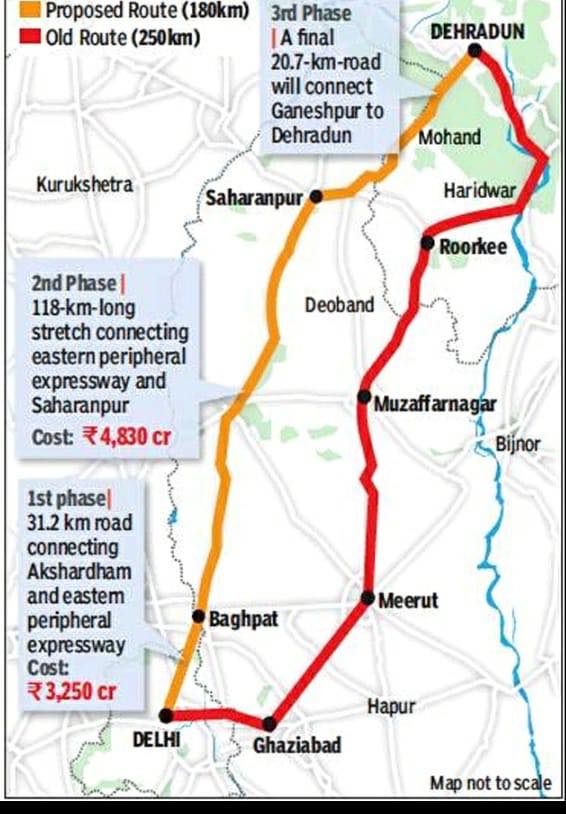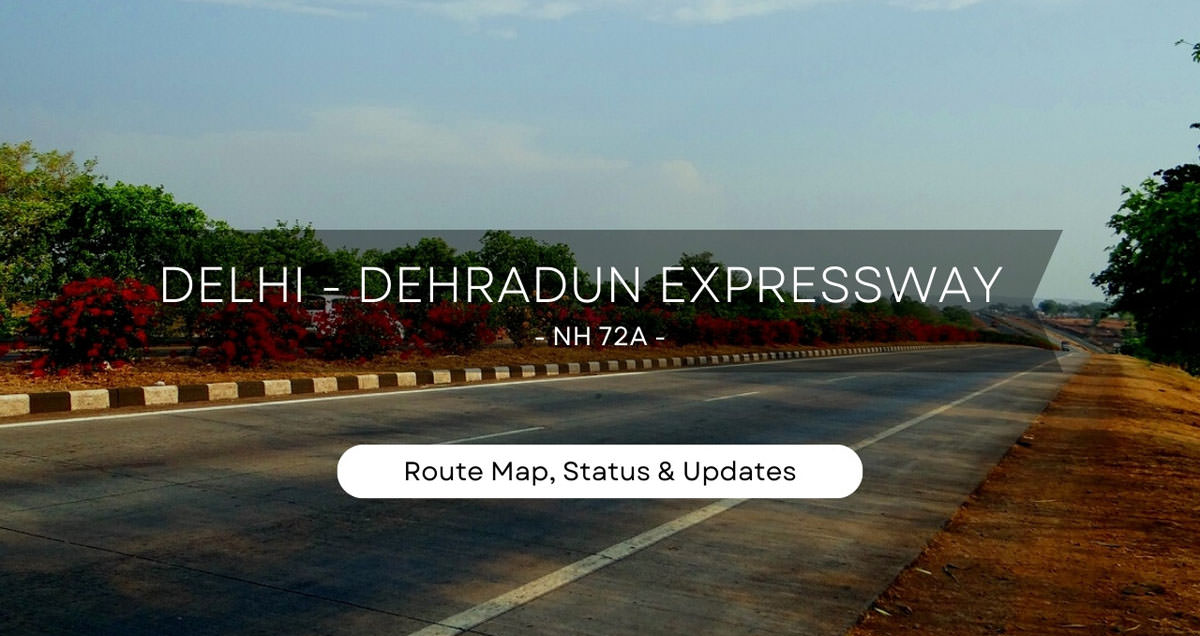The Delhi Dehradun Expressway (NH 72A) is an under-construction express highway project by NHAI whose foundation stone was laid by the Nitin Gadkari on 26 February 2021, and the Prime Minister laid its foundation stone again on December 4, 2021. It is 210 km long, six- to twelve-lane access-controlled expressway, which will connect Delhi with Dehradun. The project is being built at a cost of around ₹13,000 crore which will reduce both distance and time. It will pass through the states of Delhi, Uttar Pradesh, and Uttarakhand and the cities of Baghpat, Baraut, Shamli and Saharanpur. It will have two spurs, or link roads, to ensure connectivity with cities lying nearby to its route: one 50.7-kilometre-long (31.5 mi), six-lane Saharanpur–Roorkee–Haridwar Expressway, and another 121-kilometre-long (75 mi), six-lane Ambala–Shamli Expressway. The expressway is expected to be completed by December 2024.
It is acclaimed that Delhi - Dehradun Expressway will reduce the distance between the two cities to 210km which can be covered in a mere 2.5-3 hrs!
- Total Estimated Cost: Rs. 13,000 crore
- Project’s Total Length: 210 km
- Lanes: 12 lanes (Phase 1) and 6 lanes (Phases 2, 3 & 4)
- Completion Deadline: December 2024
- Owner: National Highway Authority of India (NHAI)
- Status: Under Construction
- Project Model: EPC (Engineering, Procurement and Construction)
Read More
How to Reach Dehradun
Delhi Dehradun Expressway Features
After the completion of the highway project the distance between the two cities New Delhi and Dehradun will be reduced from 235 km to 210 km and the journey time will be reduced to 2.5-3 hours only. The main highlight of this project is the wildlife friendly corridor which includes the 12km elevated road, six animal underpasses, two elephant's underpasses, two large bridges and thirteen smaller bridges which will make it the first highway of India to have a wildlife protection corridor and Asia’s longest wildlife elevated corridor for unrestricted wildlife movement.
A minimum speed of 100 km/h will be maintained while traveling through this corridor. A closed toll mechanism would be approved to allow toll pay only to the extent of the highway used. The expressway is built with 113 VUP (Vehicular Under Passes), LVUP (Light Vehicular Under Passes), SVUP (Small Vehicular Under Passes), 5 ROBs, 4 major bridges, and 62 bus shelters. In addition to the 76 km service road and 29 km elevated road, 16 entry-exit points are being constructed.
Delhi - Dehradun Bus Schedule
Delhi Dehradun Expressway Route Map

Old route:
Delhi-Ghaziabad-Meerut-Muzaffarnagar- Saharanpur-Dehradun
New route:
Delhi - Bhagpat(UP) 1st Phase- 31.2 km
Bhagpat - Saharanpur 2nd Phase- 118km (7 interchanges 60 underpasses)
Saharanpur - Ganeshpur 3rd Phase-40km
Ganeshpur - Dehradun 4th Phase- 20.7km (This section will consist of 2.322 km twin tunnels and 0.3 km approach, 4.82 km 4 lane elevated flyover with 6m vertical clearance for elephants and other wildlife, a 2.12 km hill section and 340m single tube tunnel)
Delhi - Dehradun Trains Schedule
Phases of the Project
Phase 1- The expressway would begin at Akshardham Temple, New Delhi. In Phase 1, there will be a total of 12 lanes.
- Range: Akshardham in Delhi to Baghpat's Eastern Peripheral Expressway Interchange
- Type: Brownfield Upgrade
- Distance: Covering a distance of 32 kilometers.
- Lanes: Consisting of 12 lanes in total, with 6 dedicated to express traffic and another 6 for local use.
Phase 2- This phase will extend from the Baghpat (UP) and ends at Saharanpur (UP) Bypass. To provide easy access to nearby communities, the second phase will add two more lanes and four more interchanges. The administration has also planned to construct at least 60 underpasses to facilitate traffic flow further. In every 25 km long stech NHAI has proposed to build the Facilites for the people like hotels, petrol pumps etc.
- Range: Baghpat’s Eastern Peripheral Expressway Interchange to Saharanpur Bypass
- Type: Greenfield
- Distance: Covering a distance of 118 kilometers
- Lanes: Designed with 6 lanes to facilitate smoother traffic flow
Phase 3- The Saharanpur Bypass in Uttar Pradesh would be the starting point for this phase and will link Ganeshpur, which is close to Sunderpur, in Uttarakhand, to Biharigarh. This segment will be about 40 kilometres long and feature six lanes. It will entail the development of brownfields, the expansion and improvement of the current highway network, and the building of lanes and pedestrian crossings.
- Range: Spanning from Saharanpur to Ganeshpur
- Type: Brownfield Upgrade
- Distance: Covering a stretch of 40 kilometers
- Lanes: Configured with 6 lanes for efficient traffic management
Phase 4- Ganeshpur and Dehradun will be connected by the Dehradun-Delhi Expressway’s final phase, which will go via the Daat Kali Devi Tunnel. The expressway will be constructed in the middle of a massive forest region that includes the Rajaji Tiger Reserve and the Shivalik Hills. It might be as lengthy as 20 kilometres with 6 lanes. Workers will improve upon the preexisting road system for the first six kilometres. An elevated corridor will likely be built for the remaining 14 kilometres of unfinished infrastructure. As a result, passengers can look forward to Phase 4. It will be visually and experientially distinct from the previous phases.
- Range: Extending from Ganeshpur to Dehradun.
- Type: Brownfield Upgrade
- Distance: Covering a distance of 19.508 kilometers.
- Lanes: Configured with either 4 or 6 lanes
IMPACT OF THE PROJECT
- On the people- this project will minimize the journey time of the passenger between the cities which will eliminate the traffic also. It will of great importance to the senior citizens as they can travel to Dehradun to visit temples and the other tourist places. It will also provide the scenic view to the traveller as it has proposed to build bird sanctuary and plant tress across the lanes of the road. It will provide seamless connectivity by decreasing logistics costs and will also provide the employment to the nearby people.
- On the environment - this project the corridor has been built over the Rajaji National Park which is wildlife friendly and said to be India's first of its kind. It will decrease the chances of animal vehicle collision and will also help in the conservation of the wildlife habitat and the biodiversity of the region. Less interaction of animals with vehicles will also reduce the stress level.
- On the Real Estate –the expressway would end the traffic jams in Noth east Delhi which will result in the increase in the real estate area around it. It will also help in the connection between Delhi and Ghaziabad which will improve the local market around it. It has also anticipated that residential development project will boom near this highway project Strech, and people will invest in acquiring them. Delhi Dehradun trips are also expected to increase which will open the gates for hotels, restaurants and cafe.
Current Status
Phase 1 & Phase 4 of Delhi Dehradun Expressway will open for public soon after inauguration.
Under Phase 1 expressway, 14.75 km portion falls in Delhi. It starts from Akshardham and goes till Loni border. Five entry and exit points have been made in this part. In this part of the expressway, exit and entry points have been made at Akshardham, Gandhi Nagar-Geeta Colony, ISBT-Dilshad Garden Marg, Khajuri Pusta Marg and Signature Bridge Marg.
Under Phase 4, expressway starts from Ganeshpur in Saharanpur district, 14 km till Asharodi, a long elevated road has been built. The 12 km elevated corridor built specifically for wildlife is the longest wildlife corridor in Asia. Vehicles coming from Meerut-Delhi-Saharanpur will now enter Doon through the elevated road from Ganeshpur.
